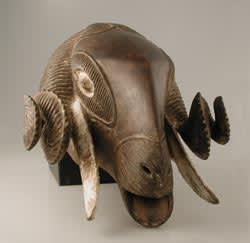Baule Wooden Mask of a Ram, 20th Century CE
Wood
12.5 x 15
PF.5895
Further images
The ram, and in specific the ram’s horns, have been a potent symbol in world mythology throughout the ages. Ancient Egyptians worshipped multiple gods with ram’s heads including Khnum and...
The ram, and in specific the ram’s horns, have been a potent symbol in world mythology throughout the ages. Ancient Egyptians worshipped multiple gods with ram’s heads including Khnum and the composite deity Amen-Ra. The Ancient Phoenician deity Ba’al, who was adopted by the Greeks as Zeus, was often depicted crowned with the horns of the ram. Throughout time, spanning across divergent cultures and civilizations, the ram has been a traditional symbol of male fertility and the hearth. The power and majesty of this beast has been long revered by mankind, and this was especially true of the Baule tribe who identified the ram and their tribal symbol.
Masks are commonly used among many African cultures to facilitate the bond between the people and their ancestors and divinities. Masks instill social order, and can bring forth prosperity as well as misfortune. They are used in ceremonies of rites of passage and are usually accompanied by elaborate music and choreography. Among the Baule, who are believed to over a million people, there are two general forms of masks: animal and human. This mask is of a type that would have been worn and danced with during the Goli festival related to the harvest and to funerals of important tribal leaders. The wearer would have been covered in an elaborate costume hiding his body beneath. Thus the illusion proffered by the mask would be completed. The mask seeks not to disguise the wearer but to transform him into a medium through which the spirit world could communicate with the villages using the language of rhythm and gesture. The Baule judged their art by strict criteria including a smooth finish, the clarity of line, and a slight inherent asymmetry; clearly this mask would have been heralded as a masterpiece by the Baule themselves.
Masks are commonly used among many African cultures to facilitate the bond between the people and their ancestors and divinities. Masks instill social order, and can bring forth prosperity as well as misfortune. They are used in ceremonies of rites of passage and are usually accompanied by elaborate music and choreography. Among the Baule, who are believed to over a million people, there are two general forms of masks: animal and human. This mask is of a type that would have been worn and danced with during the Goli festival related to the harvest and to funerals of important tribal leaders. The wearer would have been covered in an elaborate costume hiding his body beneath. Thus the illusion proffered by the mask would be completed. The mask seeks not to disguise the wearer but to transform him into a medium through which the spirit world could communicate with the villages using the language of rhythm and gesture. The Baule judged their art by strict criteria including a smooth finish, the clarity of line, and a slight inherent asymmetry; clearly this mask would have been heralded as a masterpiece by the Baule themselves.









